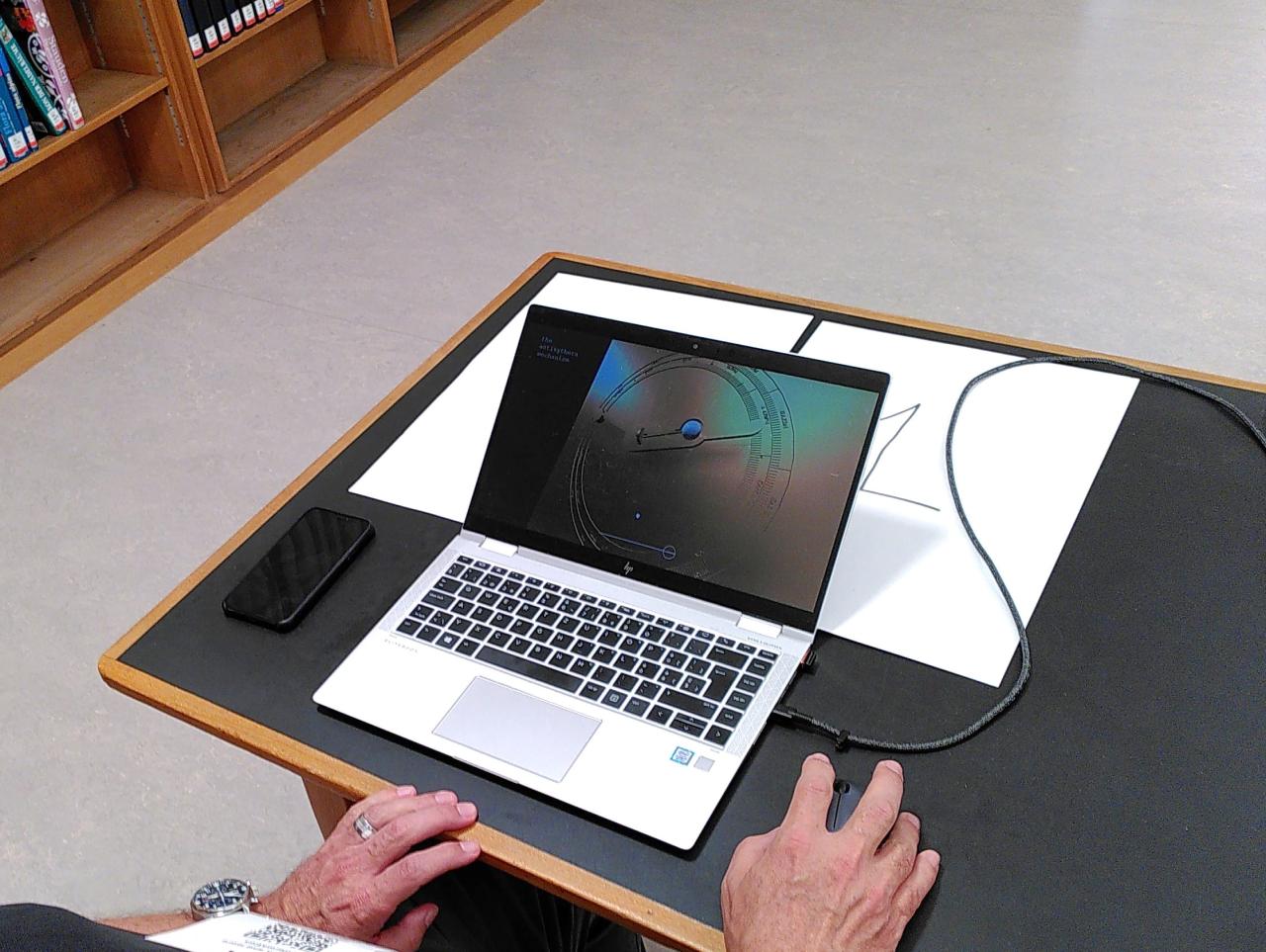 "Watch this space"
"Watch this space"
Antikythera Mechanism
The Antikythera mechanism was a dedicated astronomical calculator in Ancient Greece. The 2200 year old device is the first known analog computer in history.
In 1900, a crew of sponge divers discovered the wreck of a Roman-Greco vessel that had sunk off the coast of the Greek island Antikythera around 60 BC. Numerous artifacts, such as bronze and marble statues, amphorae, pottery, glassware, jewelry and coins, were retrieved in 1901. One of the objects was an unspectacular lump of corroded bronze that proved to be the remains of the world's first known analog computer built in Ancient Greece. The so-called Antikythera Mechanism was a hand-powered model of the solar system used to calculate astronomical cycles and to predict eclipses.
Dials
82 individual parts of the Antikythera mechanism have survived, seven large fragments, known as fragments A to G, and 75 smaller fragments, which were simply numbered from 1 to 75. All parts of the mechanism were cut out of a 1 to 2 mm thick bronze sheet. The entire mechanism was originally packed in a wooden frame or box. The extensive and still ongoing reconstruction of the mechanism revealed that it served as a model for the movements of the Sun, the Moon and the planets as observable from the earth.
The front of the mechanism contains one large dial. Above and below the dial it contained a so-called parapegma – a list with the dates of heliacal risings and settings of important stars and constellations. The base of the front dial is a solar calendar. Two ring-shaped scales are part of the dial, an inner zodiac scale and an outer date scale. The inner ring scale was divided into 12 sections for the 12 signs of the zodiac. The outer ring scale was divided into 365 sections for the 365 days of the year according to the Egyptian calendar: 12 months of 30 days each and 5 additional days. The movement of the Sun, the Moon and the 5 planets known at the time – Mercury, Venus, Mars, Jupiter and Saturn – were visualised on the front. The current position of the celestial bodies in the zodiac at a certain point in time could be read off on the front dial. Additionally, the front contained a sphere, which illustrated the current phase of the moon.

The back of the mechanism contains two large and three small dials. The basic unit of the two large back dials is the synodic lunar month. The upper large spiral-shaped dial is a lunar calendar which was scaled with the 13 month names of a lunisolar calendar used at the time. When the sun pointer on the front was turned 19 times (19 solar years), 235 synodic months were traversed on the back. This astronomical connection between 19 solar years which equal 235 synodic months with good precision is known as the Metonic cycle. The large upper dial encompasses two smaller dials. The existence of the one on the left side is backed by the discovery of the number 76 in the inscriptions. This led to the assumption that this refers to the 76-solar-year Callippic cycle. The Callippic cycle consists of four Metonic cycles, after which one day had to be skipped in order to realign the solar and lunar time-keeping. The upper right dial is the so-called games dial. It contains the names of several important pan-hellenic feasts such as the Olympiads and of some smaller local ones within a four-year cycle.
The lower large spiral-shaped dial on the back is an eclipse calendar which was scaled with 223 synodic lunar months, the so-called Saros period. After 223 synodic lunar months eclipses repeat under similar circumstances. The synodic months in which a solar eclipse and/or a lunar eclipse took place were marked with glyphs. In the current reconstruction the large lower dial encompasses one smaller dial. It is tightly connected with the eclipse calendar – it extends the eclipse calendar to three times the value of the Saros period. One Saros period has a surplus of about eight hours. After three Saros periods – one Triple-Saros or Exeligmos – this surplus adds up to 24 hours and thus one full day. The small Exeligmos dial was divided into three sectors, which indicated whether the time of day indicated on the main scale applied, or whether 1/3 or 2/3 days were to be added.
Project
The Antikythera Mechanism project @ https://www.thomasweibel.ch/antikythera/ was a challenge entry for the 10th Swiss Open Cultural Data Hackathon taking place on Sept 6/7 in Lucerne. It aims at providing an accurate and freely accessible VR model for education and study porposes. The project visualizes the mechanism according to the actual findings in the existing fragments, despite plausible speculations proposing additional gearwork also visualizing the movements of the five planets (Mercury, Venus, Mars, Jupiter and Saturn) known at the time.
The VR model can be downloaded here (GLB format, 42MB) and viewed here.
Sources
- Almagest, International Journal for the History of Scientific Ideas 2016.1: The Inscriptions of the Antikythera Mechanism (https://www.brepolsonline.net/toc/almagest/2016/7/1)
- Aristeidis, V., Christophoros, M., & Andreas, V. (2023). Reconstructing the Antikythera Mechanism lost eclipse events applying the Draconic gearing the impact of gear error. Cultural Heritage and Modern Technologies, (1), 1-68.
- Efstathiou, K., Efstathiou, M., & Basiakoulis, A. (2023). The artistic complexity of the Antikythera Mechanism: a comprehensive tutorial. Proceedings of the European Academy of Sciences and Arts, 2.
- Freeth, T. (2012). Building the cosmos in the Antikythera mechanism. From Antikythera to the Square Kilometre Array: Lessons from the Ancients, 18.
- Freeth, T., Bitsakis, Y., Moussas, X., Seiradakis, J. H., Tselikas, A., Magkou, E., ... & Edmunds, M. G. (2006). Decoding the Antikythera mechanism: investigation of an ancient astronomical calculator. Nature, 444(7119), 587-591.
- Freeth, T., Higgon, D., Dacanalis, A., MacDonald, L., Georgakopoulou, M., & Wojcik, A. (2021). A Model of the Cosmos in the ancient Greek Antikythera Mechanism. Scientific reports, 11(1), 5821.
- Freeth, T., Jones, A., Steele, J. M., & Bitsakis, Y. (2008). Calendars with Olympiad display and eclipse prediction on the Antikythera Mechanism. Nature, 454(7204), 614-617.
- Freeth, T., & Jones, A. (2012). The cosmos in the Antikythera mechanism. ISAW Papers.
- Freeth, T. (2014). Eclipse Prediction on the Ancient Greek Astronomical Calculating Machine known as the Antikythera Mechanism, PLoS One 9.7, 1-15. (https://journals.plos.org/plosone/article?id=10.1371/journal.pone.0103275)
- Freeth, T. (2022). An Ancient Greek Astronomical CalculationMachine Reveals New Secrets, Scientific American 326.1, 24-33. https://doi.org/10.1038/scientificamerican0122-24
- Gautschy, R., & Battistoni, F. (2020). Der Antikythera-Mechanismus, in: R. Färber & R. Gautschy (Hrsg.), Zeit in den Kulturen des Altertums. Antike Chronologie im Spiegel der Quellen, 419-434.
- Iversen, P. A. (2017). The calendar on the Antikythera mechanism and the Corinthian family of calendars. Hesperia: The Journal of the American School of Classical Studies at Athens, 86(1), 129-203.
- Iversen, P., & Jones, A. (2019). The Back Plate Inscription and eclipse scheme of the Antikythera Mechanism revisited. Archive for History of Exact Sciences, 73, 469-511.
- Jones, A. (2017). A portable cosmos: revealing the Antikythera mechanism, scientific wonder of the ancient world. Oxford University Press.
- Jones, A. (2019). Antikythera Mechanism Fragment A 3D model. New York University. Faculty Digital Archive. https://archive.nyu.edu/handle/2451/60402
- Oechslin, L. (2014). Antikythera. Ochs und Junior. https://www.ochsundjunior.swiss/de/antikythera/
- Voulgaris, A., Mouratidis, C., & Vossinakis, A. (2018). Conclusions from the functional reconstruction of the Antikythera Mechanism. Journal for the History of Astronomy, 49(2), 216-238.
- Voulgaris, A., Mouratidis, C., & Vossinakis, A. (2022). Assembling The Fragment D On The Antikythera Mechanism: Its Role and Operation in The Draconic Gearing. Mediterranean Archaeology and Archaeometry, 22(3), 103-103.
Team
Prof. Dr. Rita Gautschy, University of Basel/DaSCH
Prof. Thomas Weibel, University of Applied Sciences of the Grisons/Berne University of the Arts
Event finish
Research
Project
 Working prototype up and running (for link see project description).
Working prototype up and running (for link see project description).
Research
Start
Joined the team
Project
Minor text formatting - greetings from Opendata.ch/2024
Challenge shared
Tap here to review.
GLAMhack 2024
Cyanometer


